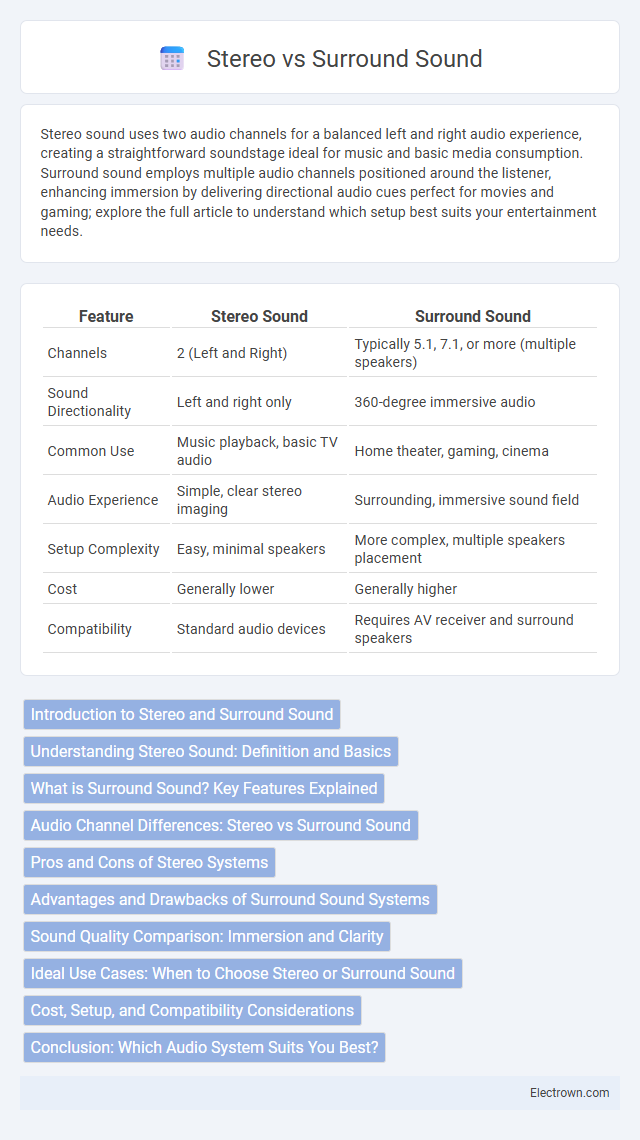Stereo sound uses two audio channels for a balanced left and right audio experience, creating a straightforward soundstage ideal for music and basic media consumption. Surround sound employs multiple audio channels positioned around the listener, enhancing immersion by delivering directional audio cues perfect for movies and gaming; explore the full article to understand which setup best suits your entertainment needs.
Table of Comparison
| Feature | Stereo Sound | Surround Sound |
|---|---|---|
| Channels | 2 (Left and Right) | Typically 5.1, 7.1, or more (multiple speakers) |
| Sound Directionality | Left and right only | 360-degree immersive audio |
| Common Use | Music playback, basic TV audio | Home theater, gaming, cinema |
| Audio Experience | Simple, clear stereo imaging | Surrounding, immersive sound field |
| Setup Complexity | Easy, minimal speakers | More complex, multiple speakers placement |
| Cost | Generally lower | Generally higher |
| Compatibility | Standard audio devices | Requires AV receiver and surround speakers |
Introduction to Stereo and Surround Sound
Stereo sound delivers audio through two channels, creating a left-right soundscape that enhances music and basic multimedia experiences with clear spatial differentiation. Surround sound expands on this by using multiple audio channels--typically 5.1, 7.1, or even more speakers--to immerse listeners in a dynamic 360-degree sound field. This technology is essential in home theaters and gaming setups, producing realistic audio positioning and depth for a fully enveloping auditory experience.
Understanding Stereo Sound: Definition and Basics
Stereo sound uses two audio channels to create a sense of dimension and direction, delivering distinct left and right audio signals through two speakers or headphones. This setup enhances the listening experience by providing spatial cues that simulate how humans naturally hear sound in an environment. Understanding stereo sound allows you to appreciate basic audio separation and clarity before exploring more complex systems like surround sound.
What is Surround Sound? Key Features Explained
Surround sound is an audio technology that uses multiple speakers placed around the listener to create an immersive, three-dimensional sound experience. Key features include spatial audio positioning, which allows sounds to originate from various directions, and multi-channel audio formats such as 5.1, 7.1, and Dolby Atmos that enhance depth and realism. This system improves audio clarity, directional accuracy, and overall sound immersion compared to traditional stereo setups.
Audio Channel Differences: Stereo vs Surround Sound
Stereo audio uses two distinct channels, typically left and right, to create a sense of width and directional audio cues for a straightforward listening experience. Surround sound expands beyond stereo by incorporating multiple audio channels--commonly 5.1 or 7.1 setups--placed around the listener to deliver immersive spatial audio and depth. This multi-channel configuration enables precise localization of sounds, enhancing realism in movies, gaming, and virtual environments.
Pros and Cons of Stereo Systems
Stereo systems provide clear, focused audio with two discrete channels, ideal for music that requires precise instrument separation and vocal clarity. You benefit from simpler setup, lower cost, and compatibility with a wide range of devices, but stereo lacks the immersive experience of surround sound and can feel limited in spatial depth for movies or gaming. Consider stereo for high-quality audio playback in smaller rooms or when budget and simplicity are priorities.
Advantages and Drawbacks of Surround Sound Systems
Surround sound systems deliver immersive audio by using multiple speakers strategically placed around the listener, creating a three-dimensional sound experience that enhances movies, games, and music. Their advantage lies in accurate sound localization and depth, making you feel like you are inside the action, though they require more space, equipment, and setup complexity compared to stereo systems. Drawbacks include potential uneven sound distribution in some rooms and higher costs, which may not suit casual listeners seeking a simpler audio solution.
Sound Quality Comparison: Immersion and Clarity
Stereo sound delivers clear, distinct audio channels that enhance clarity and definition, making it ideal for precise sound localization and vocal prominence. Surround sound systems create immersive audio environments by projecting sounds from multiple directions, enveloping listeners and replicating real-life acoustic spaces. While stereo excels in clarity and simplicity, surround sound offers superior immersion, transforming audio experiences into dynamic, realistic soundscapes.
Ideal Use Cases: When to Choose Stereo or Surround Sound
Stereo sound is ideal for music listening, podcasts, and simple audio setups where two-channel audio provides clear, balanced sound reproduction. Surround sound excels in home theater systems and immersive gaming environments by delivering multi-directional audio that enhances spatial awareness and realism. Choose stereo for content focused on vocals and instruments, while surround sound suits cinematic experiences requiring enveloping, dynamic soundscapes.
Cost, Setup, and Compatibility Considerations
Stereo systems typically cost less than surround sound setups, making them budget-friendly for casual listeners. Stereo setup involves just two speakers and is straightforward to install, compatible with most music players and TVs. Surround sound requires multiple speakers and a receiver, increasing complexity and cost, but offers immersive audio for home theaters, though it may face compatibility issues with some devices.
Conclusion: Which Audio System Suits You Best?
Choosing between stereo and surround sound depends on your listening environment and audio preferences. Stereo systems deliver clear, balanced sound ideal for music enthusiasts and smaller spaces, while surround sound setups create immersive experiences suited for home theaters and gaming. Assess your budget, room size, and content type to select the audio system that best enhances your entertainment experience.
Stereo vs Surround Sound Infographic

 electrown.com
electrown.com